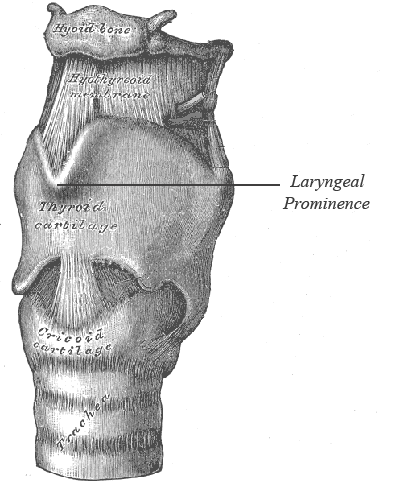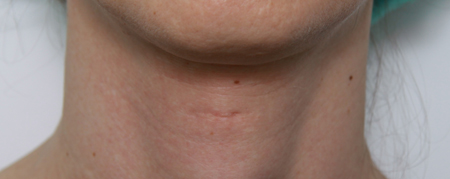Adam's Apple
Gender Differences:
Both men and women have adam's apples. In cis men they can be very large and clearly visible. In cis women, they are often invisible but not always, and despite what many people believe, it's actually not that unusual to see a cis woman with a visible adam's apple.
The main problem area is a V-shaped structure called the "laryngeal prominence". You can see it in this illustration:

Surgical Options:
The Adam’s apple can be reduced with a procedure called a “tracheal shave” or “trach shave”. Another name for this procedure is “chondrolaryngoplasty” but you may also hear it referred to as “thyroid cartilage reduction” or “TCR” for short.
The incision is sometimes made in the neck directly on the adam's apple. This is not a good approach because it leaves the scar in a very visible place. Some surgeons will tell you that the scar will be invisible. This is not true. The photo below (that someone has been kind enough to let me use) shows a typical example of one of these scars. Some are better than this but many are much worse.

And the surgeon does not have complete control over the scar - some people scar more easily than others, and some people might scar lightly on one occasion but badly on another.
This approach can also cause "adhesions" where the scar tissue from the incision sticks to the Adam's apple, and that causes the skin of the neck to be tugged up and down as the adam's apple moves when you are talking etc.
The more advanced approach is to make the incision under the chin near to the area where the chin meets the neck and in a natural crease of the skin if possible. The surgeon then tunnels down to the Adam's apple under the skin. The advantage of this approach is that the scar is much less visible because it's hidden under the chin, and it also avoids the risk of adhesions.
There are now some surgeons accessing the Adam's apple though and incision in the mouth. This would leave no visible scar, but it makes access harder and I do not know yet whether the benefits outweigh the risks.
Some Questions:
Is it true that the adam's
apple becomes harder as you age?
Yes, over time it gradually becomes more like bone than cartilage.
However, this shouldn't limit the amount you can remove - it just means
that they may have to use a different sort of burr.
How large is the incision
under the chin?
People sometimes assume that because the incision under the chin is some
distance away from the adam's apple, that it will have to be
big and will leave a big scar, but it's actually very small - 1.5 cm is
typical.
Can adam's apple reduction
surgery damage your voice?
If it isn't done correctly, then yes. The surgeon needs to be careful not to
remove too much cartilage, and must also make sure they are removing it
from the right area.
Can you do adam's apple
surgery under local anaesthetic?
Technically yes, but it makes it more difficult because if you are awake,
you might swallow or otherwise move it when the surgeon is working on it.
If I am having voice surgery,
should I have it before or after a tracheal shave?
Generally, it's best to do the tracheal shave first, but speak to
your voice surgeon to ask about their protocols.
Dr Spiegel has written an article on the procedure that you can read here.
And you can see Facial Team's 3D animation of the procedure here.